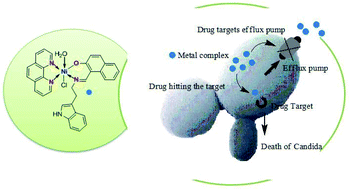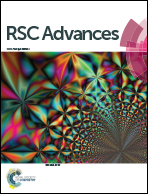New transition metal complexes with a pendent indole ring: insights into the antifungal activity and mode of action†
Abstract
Development of new chemotherapeutic agents to treat multidrug-resistant fungal infections to augment the current treatment options is a must. In this direction, a series of mixed ligand complexes was synthesized from a Schiff base (L) obtained by the condensation of 2-hydroxynapthaldehyde and tryptamine, and 1,10-phenanthroline (1,10-phen) as a secondary ligand. Based on spectral characterization and physical measurements an octahedral geometry was assigned to [Co(phen)LClH2O] (C2), [Ni(phen)LClH2O](C3), and [Zn(phen)LClH2O](C4) complexes while a distorted octahedral geometry was assigned to the [Cu(phen)LClH2O](C1) complex. All the synthesized compounds were tested for antifungal activity against 11 Candida albicans isolates, including fluconazole (FLC) resistant isolates, by determining minimum inhibitory concentrations and studying growth curves. MIC results suggest that all the newly synthesized compounds have potent antifungal activity at varying levels. The rapid action of these compounds on fungal cells suggested a membrane-located target for their action.



 Please wait while we load your content...
Please wait while we load your content...